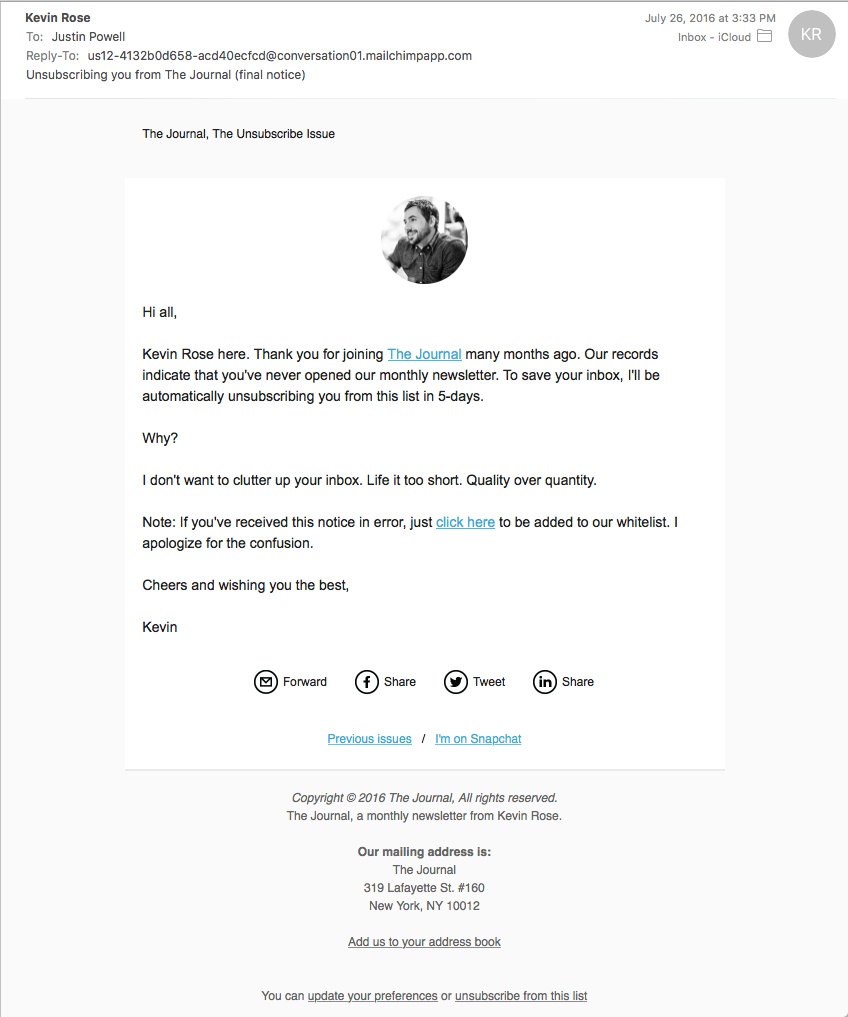Businesses spend a lot of time growing their email lists, but savvy email marketers know it’s better to have an engaged list than a big list. Kevin Rose from Digg recently sent an email telling me he was going to unsubscribed me from his email list because I hadn’t opened an email in a while. I thought I had read them, but it doesn’t matter because his ‘Call to Action’ was for me to add myself to his whitelist…which means his email is sure to land in my inbox and allows him to continue to put “58,120+ SUBSCRIBERS, 70%+ OPEN RATE. NO SPAM.” on his minimalistic website.
I LOVE THIS STRATEGY. I wish more businesses would adopt the quality over quantity philosophy. Would you rather write your emails for people who you knew were going to get it and, in turn, measure the analytics from people who care about your brand? Or would you rather write emails for people whom you don’t know and then measure the analytics of an unengaged crowd? I know what I would rather do. This is also a genius move towards increasing the deliverability of his email.
In a related story, I had a friend get notified by his Email Service Provider (ESP) that they had removed over 90% of his list due to a high level of abuse reports. Which is crazy because it was a darn good email…one the best I had read in a while. He was given one shot to email his whole list to get people to opt back into receiving his emails….and that’s when it hit me:
Was the email from The Journal by Kevin Rose a clever approach to getting people to opt into his emails after abuse complaints? There’s no way of knowing, but I realized that this strategy applies to my friend’s scenario too.
I forwarded Kevin’s email on to my friend and typed up a summary of what I like about this email. I thought I’d share that email here along with a screenshot of the email I’m referring to:

Here’s the email I wrote to my friend. There’s no eloquent prose here…just a quick and dirty, stream-of-thought list.
Here’s the email I’ve mentioned.
Note a couple of things:
1. He says that he’s going to be unsubscribing the reader…meaning, it may or not be his choice, but he’s spinning it as though it is.
2. He says “Final Notice” in the subject. This lets readers know that this is it and it’s serious. I don’t think I ever got a first notice, but this strategy works and is true because for him, it might the final chance he gets to engage his list.
3. He calls it the ‘Unsubscribe Issue’…he makes it clear that there will be action on his part.
4. First paragraph: It’s not true, I did open one of his emails, but he needed to say this to those on his list who haven’t opened. He puts a link to his site to refresh people on what The Journal is. This way, even if people do unsubscribe, he gets some web traffic.
5. General message: It’s short. To the point. Doesn’t beat around the bush. He states clearly that his purpose is to add value, not be a time suck. I think this is crucial to communicate (and then deliver on).
6. He acknowledges that this may not be an accurate message and gives a link to be added to the whitelist. If he had left this out of the email he would have missed the chance to do two things: Track the people that really want to be engaged (he can see everyone who clicks this link) and increase his future deliverability. I added myself to the whitelist just because it was there. I would have never done this otherwise.
7. Gives the standard social media plug. This is helpful as you can then see which users click on which social platforms…and this may help you determine which channels to spend more time and effort on.
I hope this helps! Please let me know if you need any other help with email stuff. I can also set you up on the software that I told you about that you may like using more.
Thanks again for breakfast/coffee this morning. I was really encouraged and glad to get to know you more.
later,
Justin
I hoped this helped out my friend…and speaking of helping him: Go to sign up for his newsletter here. It’s worth it.
I also hope that my ‘Anatomy of an Unsubscribe’ breakdown is helpful.


